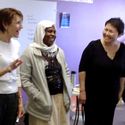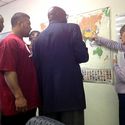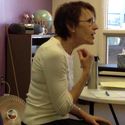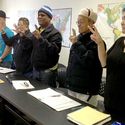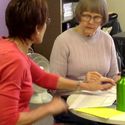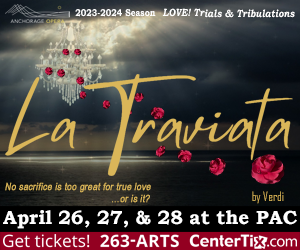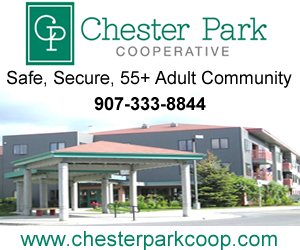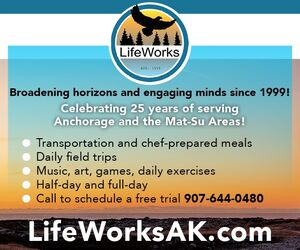Changing lives through literacy
The Alaska Literacy Program in Anchorage
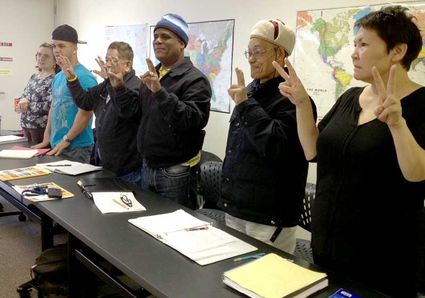
Dianne Barske
Students at the Alaska Literacy Program learn the word "fingers" – and then learn the peace sign. Last year, 65 volunteer instructors taught more than 1,000 English language learners at the Anchorage program.
I sat there, transfixed by the diversity in the room.
"Sad, sadder, saddest," Cindy Johnson said to the group. She wrote the three words on the board at the front of the classroom, then drew simple faces wearing these three expressions. She passed out paper. "Draw," she told the class.
It seemed as if the world had found its way to one room that morning. Sitting at the long, classroom tables were several people from both Sudan and the Dominican Republic, someone from Somalia and Mexico, individuals from Kazakhstan, Russia, Peru, Bhutan, Laos, Puerto Rico and South Korea. The fifteen men and women ranged in age from 22 to 82. So many cultures and life experiences were represented, so many languages and reading abilities. How could any one person begin to communicate with this group, I wondered.
Cindy Johnson is a volunteer teacher for the Alaska Literacy Program. She faces the task of teaching these students to read, write and speak English. At first I felt they had so little in common. Then I realized they had one basic and compelling bond, one thing they shared – the determination to learn.
Drawing began to create a way to share – that, along with facial expressions and body language. I love to draw, but sat there with no paper.
"Sad!" one man said clearly, looking right at me. I hadn't realized that I had been pouting, puffing out my lower lip, wanting a piece of paper.
"Saddest," a woman said, nodding at me. Merriment followed, lots of laughter. I began to sense that we all could be earnestly intent on this learning, but could be having fun as well. They were fully engaged, and I found myself right there, with them.
The lesson that day focused on body features, expressions and comparative terms. We drew short legs, long legs; thinnest legs; curly hair and long, straight hair; happy faces and angry faces.
Cindy wrote all the adjectives on the board as we drew. "Now switch papers and see what someone else drew. What do you see?"
We were amused.
"Stand up." Cindy said. "Who is the shortest? Who is the tallest? Stand in order – short to tall."
More laughter. This was just another way to engage us all. And then there was the singing of "Head, Shoulders, Knees and Toes." That's the universality of music, I thought.
There was no doubt that learning was going on, and we were having a fine time doing that learning.
I quickly sensed that Cindy is a master teacher, that teaching comes naturally to her. She taught language arts to middle school students for many years, before gravitating to teaching English as a Second Language. She'd been on the staff of the Alaska Literacy Program (ALP) for several years, then retired and moved Outside, but since returning to Anchorage she has added more and more hours as a volunteer teacher for the program.
"Why do this?" I ask her. There are over 65 volunteer teachers at ALP, and last year alone, they taught over 1,000 students that came to the program to learn English. Cindy is currently teaching at least four classes, most of them twice a week.
"It's a privilege to teach these students," Cindy answers simply. "I get more out of it than they do."
Some of the volunteers, often seniors, call their involvement an "encore career" – a third or fourth career after what they assumed was their official retirement.
Cindy comments, "I'm here because these people are determined to make a better life, and I want to help them do that. Some of the students are pre-literate, non-readers. Some are professionals with college degrees. All have stories, amazing stories."
She laughs, adding, "I can't just stay home. Shoot me now, if I tried to do that."
Cathy Stadem is another equally committed volunteer teacher for ALP. She retired several years ago from teaching language arts at the university level.
"I love to teach," she states, "but I found it so frustrating to teach when students weren't motivated. If you want to see motivated, determined students, you only have to come here. Here I've realized what motivated students can do."
I sat in on her Citizen 1 class, the beginning classes focused on helping students prepare for the citizenship exam. There were four students there that evening – two from Sudan, and one each from Somalia and Samoa. Cathy and Cindy are team-teaching these sessions, with Cathy focusing on the citizenship information and Cindy on phonetics.
Again I was thinking, where to begin? This is new information, in a new language, often to new readers. They will need to know information about presidents, the Constitution, U.S. history, the states and their capitals, Congress. There's a spelling lesson this evening, too – words like ally, conflict, enemy, Communism.
Tonight we are learning the word "current," and facts about current wars. With my mind dizzily dancing, I am thinking that I don't know a lot of this information. We gather around a world map to see where some of these recent conflicts happened. Add in a geography lesson.
Once again, the most remarkable thing about this group of students for me is their determination. As the class is about to end, Cathy remembers a question. "If this class continues on summer evenings, who would come?" There is no hesitation. All hands are raised. Yes, they will come on summer nights.
I stop one of the students as he is leaving – Misipati, from Samoa.
"Why do you come?" I ask him.
He sits down next to me, smiling.
"I am so happy here," he states, "so happy to come! I'm happy that I begin to understand this country and its history. It means so much to me and to my family. My three sons and my wife are citizens. I want that, too. I study hard, and they are proud of me."
Going out the door, waving, he stops to add, "The teachers – my teachers here – are awesome!"
It's obvious he means this, and that he enjoys sharing the word "awesome."
"Do your homework," Cathy tells him. "You still have to do your homework."
Later, Cathy takes a moment to answer my question,"Why are you doing this?" She tells me, "Most of the refugees or immigrants here are seeking freedom. That is what the U.S. symbolizes around the world. But you can be free in body and not free in mind. That's where literacy comes in – it frees the mind."
Vounteers wanted

Dianne Barske
Alaska Literacy Program volunteer instructors Cindy Johnson, left, and Cathy Stadem prepare for their Wednesday evening Beginning Citizenship class.
Anyone interested in becoming a volunteer teacher for the Alaska Literacy Program will have the opportunity to become part of the training this May. Fifteen hours of training are required, including some classroom observation. There will be three training workshops this month, on May 13, May 20 and May 27, from 2:30 p.m.to 5:30 p.m. each date. These are held at the ALP offices and classrooms, 13345 Rudakof Circle, Anchorage.
A commitment to teach two class sessions is also required. Most classes run 10 weeks, for an hour and a half, so the commitment is for three hours a week.
In addition to the volunteers who are teaching, there are opportunities to volunteer for office support, fundraising events support, and to offer technical assistance.
More information is available by calling 907-338-3105.
Fairbanks
The Interior's volunteer-based literacy program is the Literacy Council of Alaska, Mike Kolasa, Executive Director, 517 Gaffney Road, Fairbanks, AK 99701. For information, call 907-456-6212.
Here's a link to the Alaska Adult Basic Education website: http://jobs.alaska.gov/abe/.

